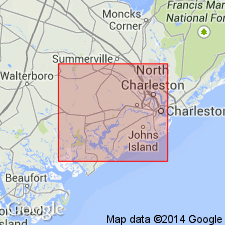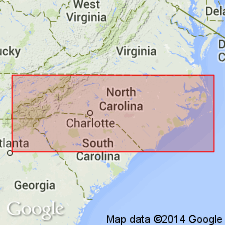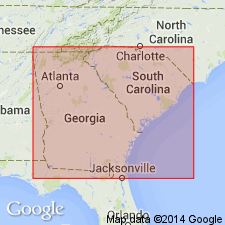
- Usage in publication:
-
- Cross Member*
- Modifications:
-
- Named
- Dominant lithology:
-
- Limestone
- AAPG geologic province:
-
- Atlantic Coast basin
Summary:
Named as a member of Santee Limestone. Named for town of Cross near type section at Martin Marietta Co. quarry, 2.4 km south of intersection of SC Hwys 6 and 59, Berkeley Co., southeastern SC. Consists of grayish-yellow biomicrite, deeply burrowed and containing bryozoans, brachiopods, and bivalves. Thickness averages 1 m, but ranges from 1 to 41 m. Unconformably overlies Moultrie member of Santee Limestone; unconformably underlies Raysor Formation at type section, or Harleyville Member of Cooper Formation elsewhere. Age is middle Eocene (Claibornian).
Source: GNU records (USGS DDS-6; Reston GNULEX).

- Usage in publication:
-
- Cross Member*
- Modifications:
-
- Areal extent
- AAPG geologic province:
-
- Atlantic Coast basin
Summary:
The middle- to outer-shelf Moultrie Member and the deeper-water Cross Member of the Santee Limestone occur south of Cape Fear in SC and GA.
Source: GNU records (USGS DDS-6; Reston GNULEX).

- Usage in publication:
-
- Cross Formation
- Modifications:
-
- Age modified
- AAPG geologic province:
-
- Atlantic Coast basin
Summary:
Formation is assigned to both the middle (Bartonian) and upper (Priabonian) Eocene based on megafauna and sequence stratigraphy. Correlates with "Sequence 3" of the Castle Hayne Formation of North Carolina.
Source: GNU records (USGS DDS-6; Reston GNULEX).

- Usage in publication:
-
- /Cross Formation
- Modifications:
-
- Revised
- AAPG geologic province:
-
- Atlantic Coast basin
Summary:
Authors follow Colquhoun and others (1983) and Nystrom and others (this volume) and herein assign all middle Eocene sediments of the outer Coastal Plain of SC to the Orangeburg Group. Therefore, in the outer Coastal Plain, the group includes the Congaree Formation, the Santee Limestone, and only the lower part of the Cross Formation. [This last assignment is in conflict with the 1983 Code, Art. 28(b). Even though the upper part of the Cross, of late Eocene age, is not assigned to the overlying Cooper Group, it's left dangling in space. The Cross Formation was determined to be one depositional sequence of middle and late Eocene age by Zullo and Harris (1987).]
Source: GNU records (USGS DDS-6; Reston GNULEX).
For more information, please contact Nancy Stamm, Geologic Names Committee Secretary.
Asterisk (*) indicates published by U.S. Geological Survey authors.
"No current usage" (†) implies that a name has been abandoned or has fallen into disuse. Former usage and, if known, replacement name given in parentheses ( ).
Slash (/) indicates name conflicts with nomenclatural guidelines (CSN, 1933; ACSN, 1961, 1970; NACSN, 1983, 2005, 2021). May be explained within brackets ([ ]).

